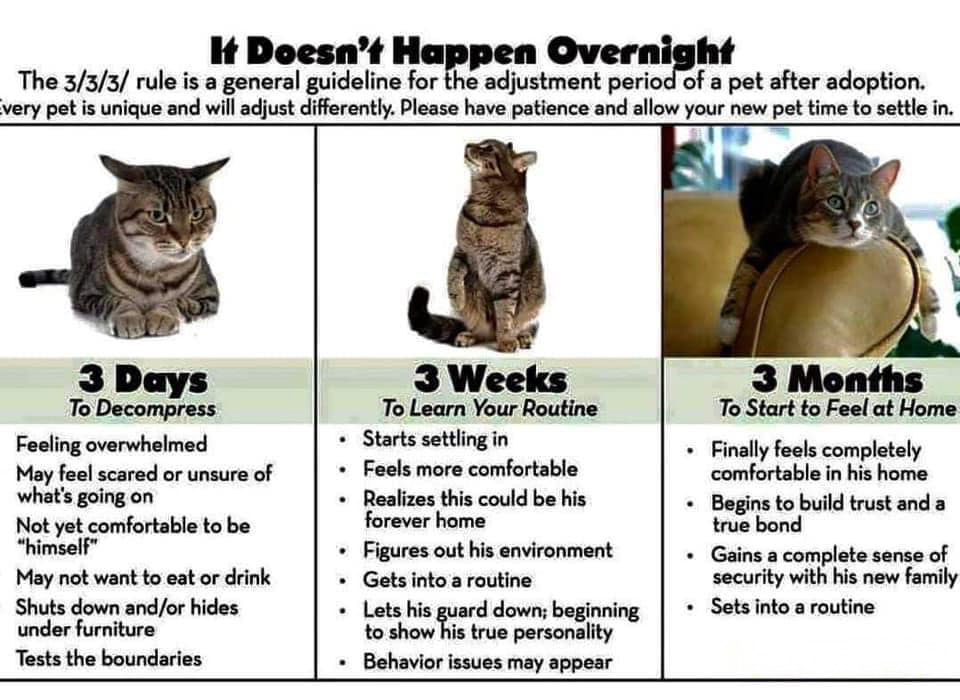Bringing a new cat into your home is an exciting and rewarding experience, but it’s crucial to recognize that cats, being creatures of habit, need time to adjust to their new surroundings. The 3-3-3 rule serves as a helpful guideline for cat owners to understand the typical adjustment periods their feline friends go through. In this blog post, we’ll delve into the details of each phase—3 days, 3 weeks, and 3 months—and emphasize the importance of patience during this transitional time.
Phase 1: The First 3 Days
During the initial three days for adjusting to a new home, adopted cats often experience a range of emotions, including distress, fear, and uncertainty. The unfamiliar environment may leave them feeling overwhelmed, causing them to retreat and hide. It’s not uncommon for cats to display minimal interest in eating or drinking during this period, as their anxiety can impact their appetite. Some may even attempt to escape, seeking refuge in corners or under furniture to cope with the stress of their new surroundings. Patience and a calm, quiet atmosphere are crucial during these early days to allow the cat the time and space it needs to gradually acclimate to its new home.
Key Tips for the First 3 Days:
- Minimal Interference: Allow the cat to approach you at their own pace. Avoid forcing interaction.
- Consistent Schedule: Stick to a routine for feeding and playtime, promoting a sense of security.
- Quiet Environment: Keep noise levels low, ensuring a peaceful and stress-free atmosphere.
Phase 2: The Next 3 Weeks
Transitioning into the second phase of the 3-3-3 rule, the next three weeks are a pivotal time for building trust and deepening your bond with your new feline friend. During this period, your cat will gradually become more comfortable with their surroundings, and your goal is to foster a sense of security and positive association.
Key Tips for the Next 3 Weeks:
- Starts to Settle In: Allowing your cat to gradually settle into their new space and providing a safe and quiet environment where they can retreat, has established a sense of security.
- Feels More Comfortable: Observe signs of increased comfort as your cat becomes more familiar with their surroundings. Encourage exploration and offer gentle reassurance.
- Figures Out This is Their New Forever Home: Through positive interactions and a consistent routine, your new feline friend starts to realize that this is their new forever home. Reinforce the bond by providing love, treats, and a welcoming environment.
- Figures Out Their New Environment: Introducing new areas of the house gradually, giving your cat time to explore and become accustomed to each space. Supervise their adventures, providing support and encouragement.
- Starts to Trust Their New Routine: Establish and maintain a consistent routine for feeding, play, and rest. A predictable schedule helps your cat feel secure, learn and understand their daily activities.
- Starts to Show Their Personality: As your cat becomes more comfortable, their unique personality may start to emerge. Enjoy observing their quirks, preferences, and individual traits.
- Behavior Issues May Start to Arise: Keep in mind that behavioral issues may arise during this time. Handling these challenges with patience and understanding is crucial for promptly addressing concerns and sustaining a positive environment. Additionally, this phase might involve your feline friend testing the waters to gauge your commitment, assessing whether you’ll provide a permanent and supportive home or consider other alternatives.
Phase 3: The Final 3 Months
By the end of the first three months, your cat should be settling into their new home more comfortably. However, complete adjustment may take longer for some cats, especially those with a more reserved nature. Continue fostering a positive environment, offering a stable routine, and maintaining a strong bond through regular interaction.
Key Tips for the Final 3 Months:
- Ongoing Patience: Recognize that each cat adjusts at their own pace, and some may take longer than others.
- Established Routine: Maintain a consistent schedule for feeding, play, and other activities to provide stability.
- Veterinary Check-Up: Schedule a check-up with the veterinarian to ensure your cat’s physical and emotional well-being.
The 3-3-3 rule serves as a valuable guide for cat owners navigating the adjustment period with their new feline companions. Remember, the key to a successful transition lies in patience, understanding, and creating a supportive environment that allows your cat to acclimate at their own pace. By following this rule and adapting to your cat’s unique needs, you’ll be rewarded with a strong and lasting bond with your furry friend.
Now is the perfect moment to delve into the blog post titled “When Fluffy Sneezes: Understanding Cat Allergies vs. Cold-Like Symptoms in New Environments.” This insightful post, available at https://dcsfelinefixers.com/when-fluffy-sneezes-understanding-cat-allergies-vs-cold-like-symptoms-in-new-environments/, sheds light on the intricate relationship between stress and cold-like symptoms in your new feline friend. Unravel the mystery behind these symptoms by exploring the impact of stress on your cat’s well-being and gain valuable insights into distinguishing between allergies and temporary environmental adjustments. This comprehensive guide will empower you with the knowledge to provide optimal care for your cat during their transition, ensuring a healthy and happy start to their new life with you. Please note that we are not veterinarians, and while it’s crucial to comprehend the impact of stress on your new feline companion, seeking professional advice is essential. If you encounter severe issues, it’s highly important to schedule an appointment with your veterinarian for proper assessment and guidance.

